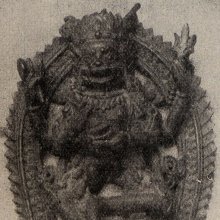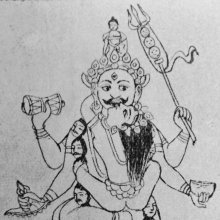Kapalini, Kapālinī: 11 definitions
Introduction:
Kapalini means something in Buddhism, Pali, Hinduism, Sanskrit. If you want to know the exact meaning, history, etymology or English translation of this term then check out the descriptions on this page. Add your comment or reference to a book if you want to contribute to this summary article.
Images (photo gallery)
In Hinduism
Shaivism (Shaiva philosophy)
Source: Wisdom Library: Kubjikāmata-tantraKapālinī (कपालिनी, “bearing a skull as alms-bowl”):—One of the nine Dūtī presided over by one of the nine bhaivaravas named Kapāla (emanation of Ananta, who is the central presiding deity of Dūtīcakra), according to the Kubjikāmata-tantra and the Ṣaṭsāhasrasaṃhitā. The names of these nine Dūtīs seem to express their involvement in yogic practices.
Source: academia.edu: Yakṣiṇī-sādhana in the Kakṣapuṭa tantraKapālinī (कपालिनी) is the name of one of the thirty-six Yakṣiṇīs mentioned in the Uḍḍāmareśvaratantra. In the yakṣiṇī-sādhana, the Yakṣiṇī is regarded as the guardian spirit who provides worldly benefits to the practitioner. The Yakṣiṇī (e.g., Kapālinī) provides, inter alia, daily food, clothing and money, tells the future, and bestows a long life, but she seldom becomes a partner in sexual practices.

Shaiva (शैव, śaiva) or Shaivism (śaivism) represents a tradition of Hinduism worshiping Shiva as the supreme being. Closely related to Shaktism, Shaiva literature includes a range of scriptures, including Tantras, while the root of this tradition may be traced back to the ancient Vedas.
Shaktism (Shakta philosophy)
Source: Wisdom Library: ŚāktismKapālinī (कपालिनी, “skull-bearer, pot-bearer”):—Name of one of the sixty-four mātṛs to be worshipped during Āvaraṇapūjā (“Worship of the Circuit of Goddesses”, or “Durgā’s Retinue”), according to the Durgāpūjātattva. They should be worshipped with either the five upācāras or perfume and flowers.
Her mantra is as follows:
ॐ कपालिन्यै नमः
oṃ kapālinyai namaḥ.
A similar mantra is mentioned by the same text, prefixed with ह्रीं (hrīṃ), to be worshipped at the goddess’s right.
Source: Google Books: ManthanabhairavatantramKapālinī (कपालिनी) refers to one of the eight Kaula consorts (dūtī-aṣṭaka) associated with Oṃkārapīṭha (also called Oḍḍiyāna, Ādipīṭha or Uḍapīṭha), according to the Manthānabhairavatantra, a vast sprawling work that belongs to a corpus of Tantric texts concerned with the worship of the goddess Kubjikā.—[...] The eight Kaula consorts (dūtī-aṣṭaka): Śivā, Ahutyagnidūtī, Koṭarākṣī, Kapālinī, Muktakeśī, Devadūtī, Tīkṣṇadaṃṣṭrā, Bhayaṃkarī.
Source: Kamakoti Mandali: The Yoginis of Narasimha VyuhaKapālinī (कपालिनी) is the name of a Mātṛkā-Śakti created by Mahārudra in order to control the plague of demons created by Andhakāsura.—Accordingly, Andhaka-Asura tried to kidnap Umā (Devī Pārvatī), and was fiercely attacked by Mahārudra who shot arrows at him from his mahāpināka. when the arrows pierced the body of Andhakāsura, drops of blood fell to earth and from those drops, thousands of Andhakas arose. To control this plague of demons, Mahārudra created Mātṛkā-Śaktis [viz., Kapālinī] and ordered them to drink the blood of the demons and drain them dry.
Source: Kamakoti Mandali: Nrisimha matrika-mandalaKapālinī (कपालिनी) refers to one of the various Mātṛkā-Śaktis created by Rudra in order to destroy the clones that spawned from Andhaka’s body.—Accordingly, [...] Andhakāsura attempted to abduct Girājanandinī (Pārvatī) and thus ensued a fierce battle between Andhakāsura and the great Rudra, the Lord of Umā. Like raktabīja, every drop of blood that fell from the body of Andhaka created another Asura like him and in no time, the entire world was filled with Andhakas. To destroy the growing number of Andhakas, Rudra created innumerable Mātṛkā-Śaktis [viz., Kapālinī]. These Śaktis of immense power at once began to drink every drop of blood that flowed from the body of Andhaka, but they could still not effectively contain the emergence of more and more demons.

Shakta (शाक्त, śākta) or Shaktism (śāktism) represents a tradition of Hinduism where the Goddess (Devi) is revered and worshipped. Shakta literature includes a range of scriptures, including various Agamas and Tantras, although its roots may be traced back to the Vedas.
In Buddhism
Tibetan Buddhism (Vajrayana or tantric Buddhism)
Source: archive.org: The Indian Buddhist IconographyKapālinī (कपालिनी) is one of the twenty-four Goddesses surrounding Buddhakapāla in the buddhakapālamaṇḍala, according to the 5th-century Sādhanamālā (a collection of sādhana texts that contain detailed instructions for rituals).—Buddhakapāla refers to one of the various emanations of Akṣobhya and the sādhana says that when Heruka is embraced by Citrasenā he gets the name of Buddhakapāla.—Kapālinī is yellow and stands in the north of the first circle.
Source: academia.edu: The Structure and Meanings of the Heruka Maṇḍala1) Kapālinī (कपालिनी) refers to one of the twenty-four Ḍākinīs positioned at the padma (lotus) in the middle of the Herukamaṇḍala, according to the 10th century Ḍākārṇava chapter 15. Accordingly, between the north and west (of the heruka-maṇḍala) are six Ḍākinīs who are half green and half red in color. They [viz., Kapālinī] are headed by the major four Ḍākinīs of the Cakrasaṃvara tradition. They stand in the Pratyālīḍha posture and, except for the body posture, their physical features and objects that they hold are the same as Vajravārāhīs.
2) Kapālinī (कपालिनी) is the name of a Ḍākinī who, together with the Vīra (hero) named Kapālin forms one of the 36 pairs situated in the Guṇacakra, according to the same work. Accordingly, the guṇacakra refers to one of the four divisions of the sahaja-puṭa (‘innate layer’), situated within the padma (lotus) in the middle of the Herukamaṇḍala. The 36 pairs of Ḍākinīs [viz., Kapālinī] and Vīras are whitish red in color; they each have one face and four arms; they hold a skull bowl, a skull staff, a small drum, and a knife.

Tibetan Buddhism includes schools such as Nyingma, Kadampa, Kagyu and Gelug. Their primary canon of literature is divided in two broad categories: The Kangyur, which consists of Buddha’s words, and the Tengyur, which includes commentaries from various sources. Esotericism and tantra techniques (vajrayāna) are collected indepently.
Languages of India and abroad
Sanskrit dictionary
Source: Cologne Digital Sanskrit Dictionaries: Edgerton Buddhist Hybrid Sanskrit DictionaryKapālinī (कपालिनी).—name of a goddess: Sādhanamālā 502.6.
Source: Cologne Digital Sanskrit Dictionaries: Monier-Williams Sanskrit-English Dictionary1) Kapālinī (कपालिनी):—[from kapālin > kapāla] f. a form of Durgā (as the wife of Śiva-kapālin), [Harivaṃśa; Kathāsaritsāgara]
2) [v.s. ...] of a being attending on Devī.
Sanskrit, also spelled संस्कृतम् (saṃskṛtam), is an ancient language of India commonly seen as the grandmother of the Indo-European language family (even English!). Closely allied with Prakrit and Pali, Sanskrit is more exhaustive in both grammar and terms and has the most extensive collection of literature in the world, greatly surpassing its sister-languages Greek and Latin.
Kannada-English dictionary
Source: Alar: Kannada-English corpusKapālini (ಕಪಾಲಿನಿ):—
1) [noun] a woman of low caste, being the daughter of a brāhmaṇa woman and a fisherman.
2) [noun] one of the forms of Goddess Durgā.
Kannada is a Dravidian language (as opposed to the Indo-European language family) mainly spoken in the southwestern region of India.
See also (Relevant definitions)
Ends with: Buddhakapalini, Candakapalini, Lokapalini.
Full-text: Buddhakapalini, Bhadrakali, Yogini, Tikshnadamshtra, Devaduti, Ahutyagniduti, Ahutyagni, Bhayamkari, Kapalin, Raktardha, Haritardhaka, Haritardha, Raktardhaka, Muktakeshi, Kotarakshi, Shiva, Gunacakra, Buddhakapala.
Relevant text
Search found 7 books and stories containing Kapalini, Kapālinī, Kapālini; (plurals include: Kapalinis, Kapālinīs, Kapālinis). You can also click to the full overview containing English textual excerpts. Below are direct links for the most relevant articles:
The Garuda Purana (by Manmatha Nath Dutt)
Chapter CXXXIV - Maha Kausika Vratas etc < [Brihaspati (Nitisara) Samhita]
Chapter XXXVIII - The mode of worshipping the deities, Durga, etc. < [Agastya Samhita]
Varahi Tantra (English Study) (by Roberta Pamio)
Chapter 29 - The worship of Caṇḍikā < [Summary of the Vārāhī Tantra]
Chapter 22 - The the Six Āmnāyas < [Summary of the Vārāhī Tantra]
The Indian Buddhist Iconography (by Benoytosh Bhattachacharyya)
The Agni Purana (by N. Gangadharan)
Chapter 145 - Different kinds of mantras and the rites of locating them
Puranic encyclopaedia (by Vettam Mani)
The Skanda Purana (by G. V. Tagare)
Chapter 17 - The breaking of ego of Rukmi and the servants of God < [Section 4 - Dvārakā-māhātmya]
Chapter 62 - The Practice of Mahāvidyā < [Section 2 - Kaumārikā-khaṇḍa]

